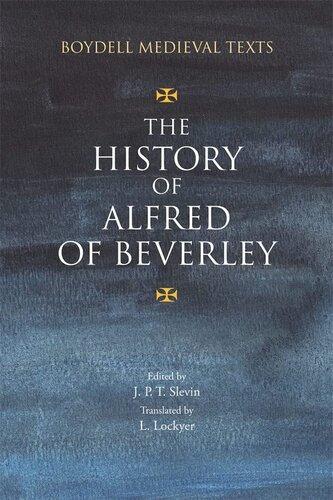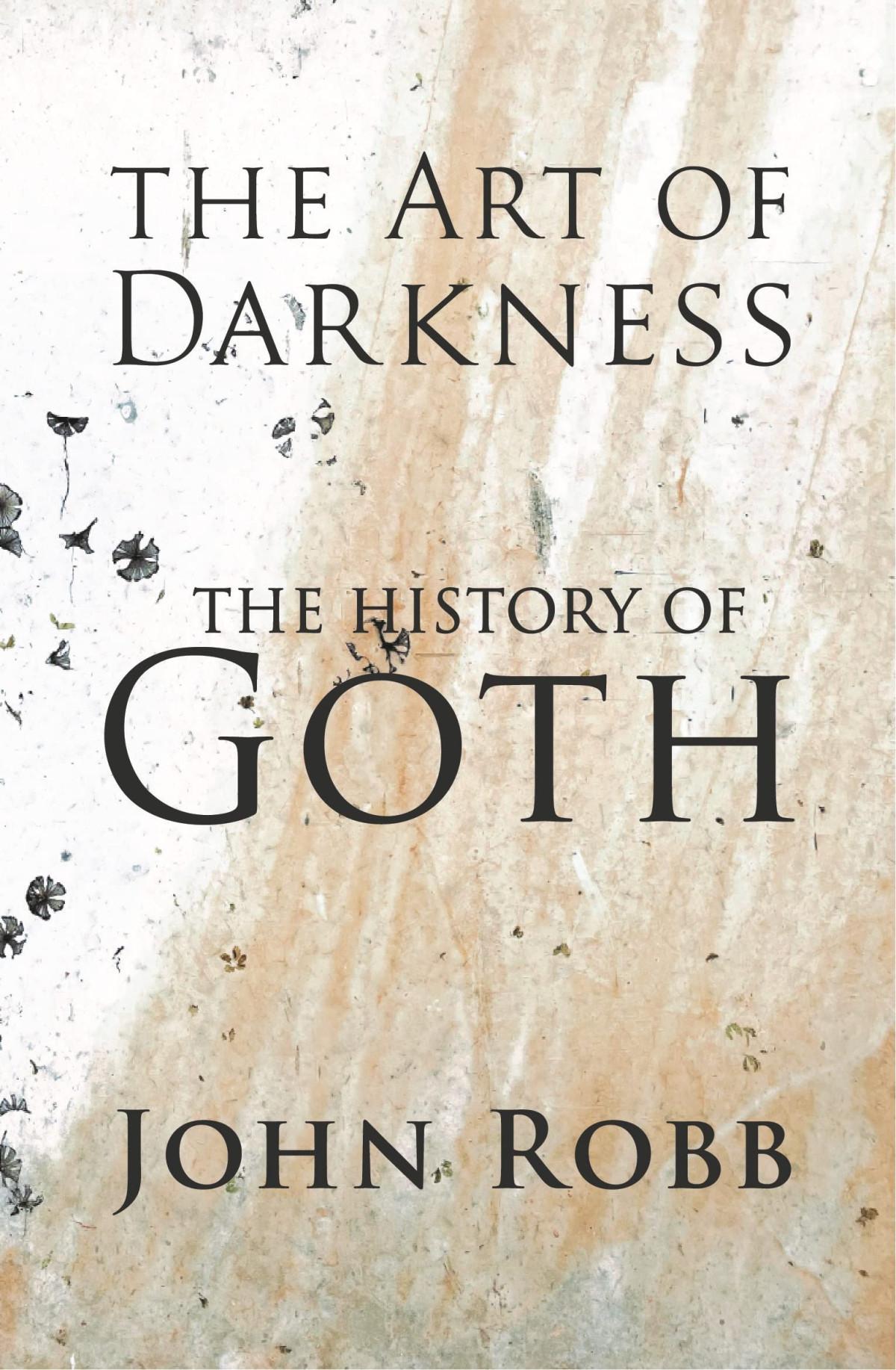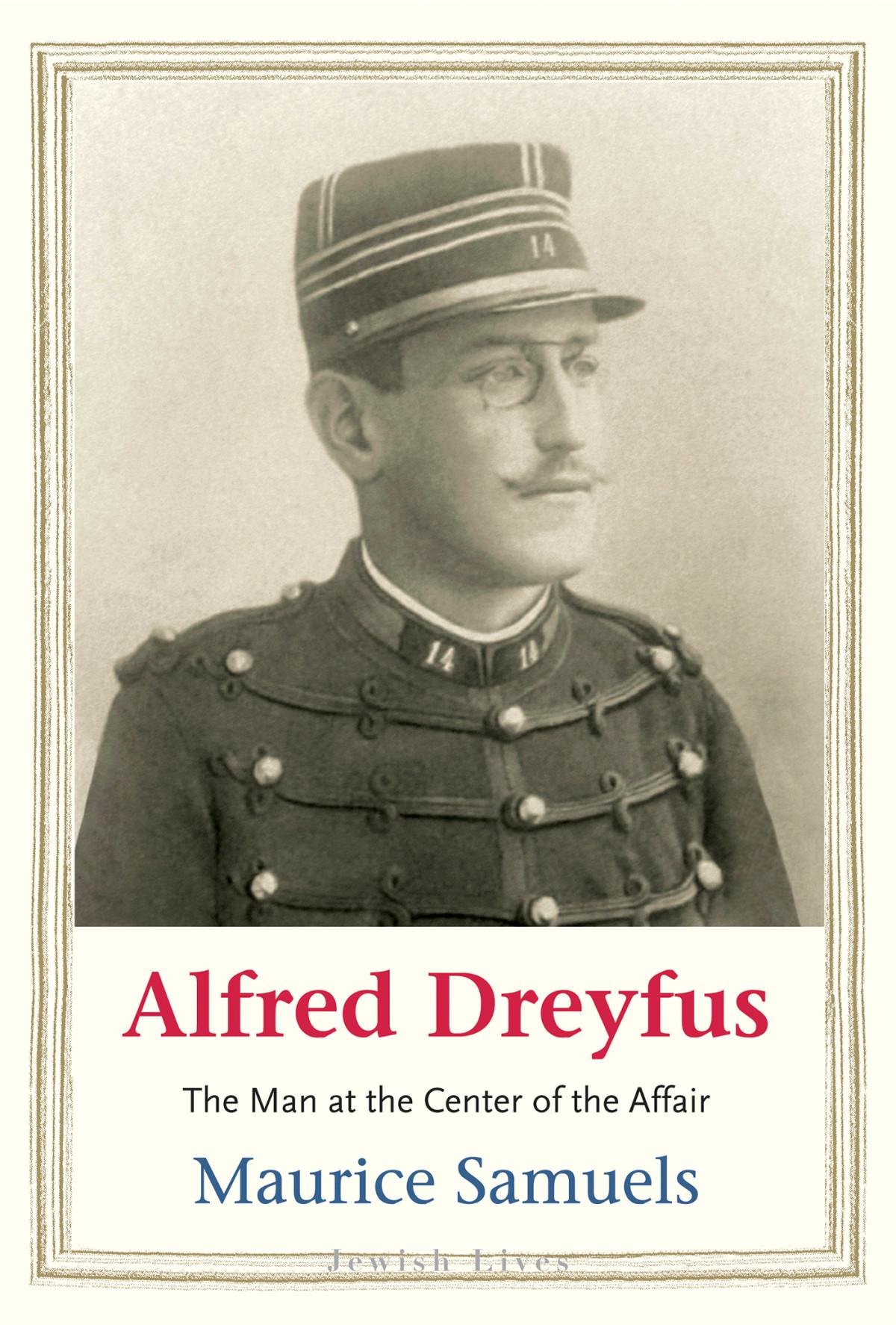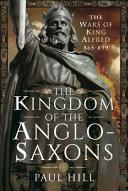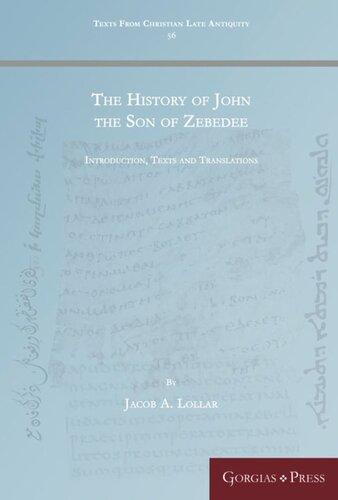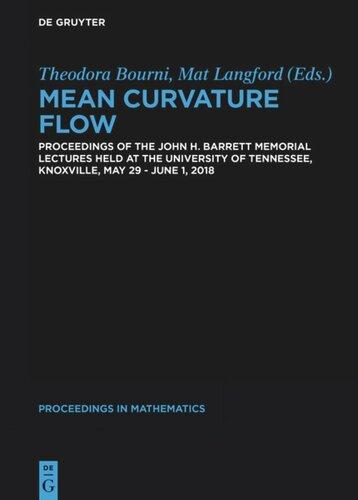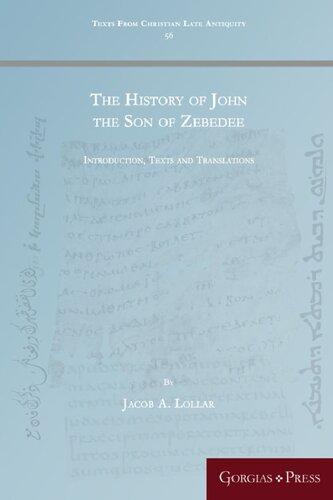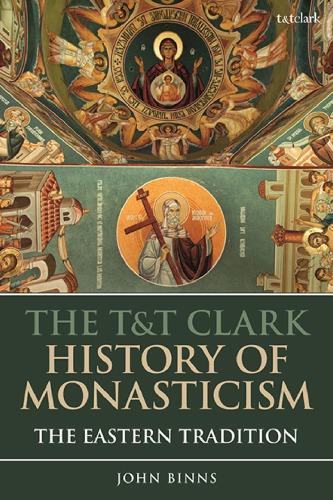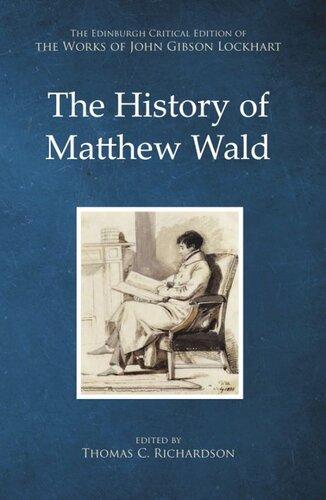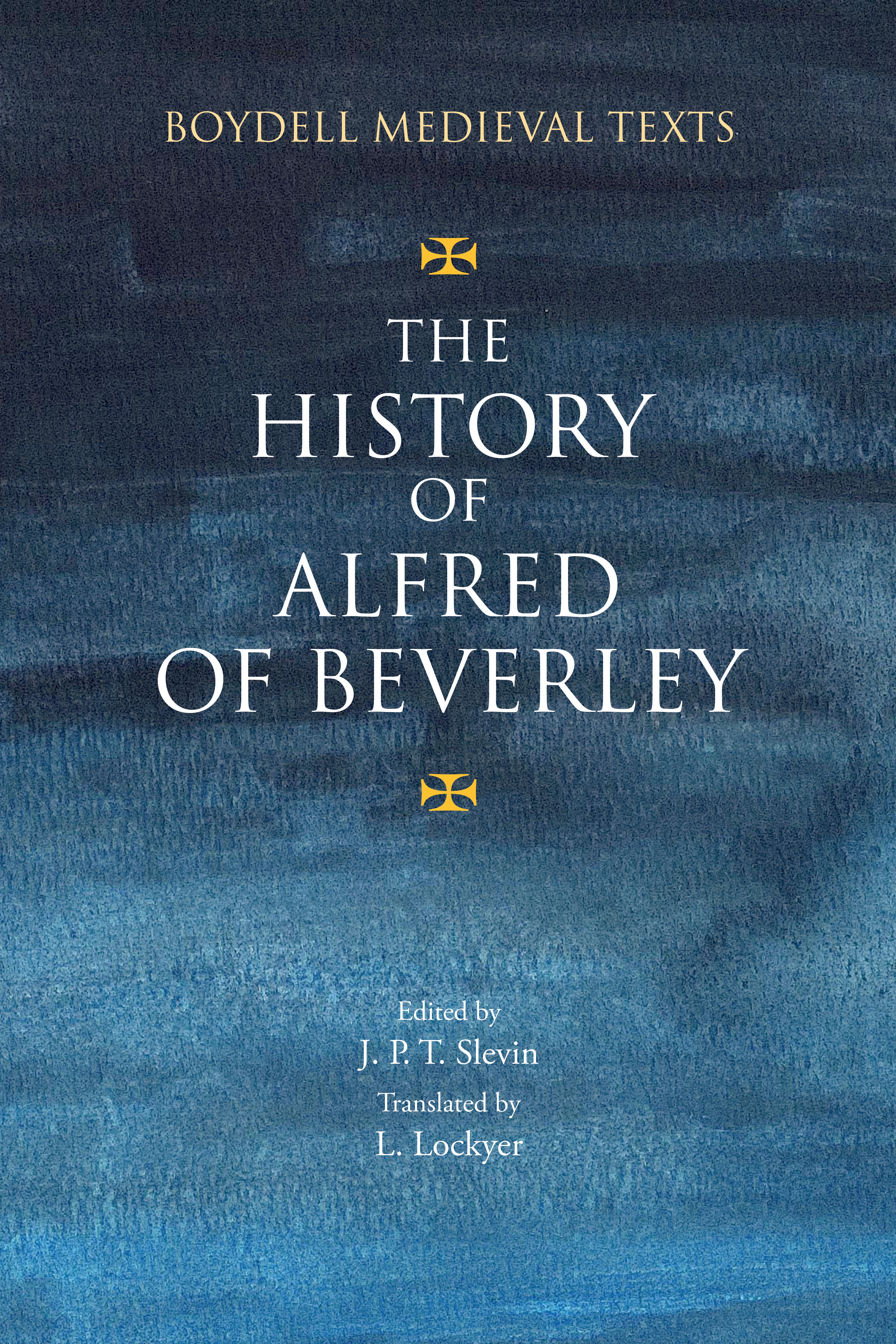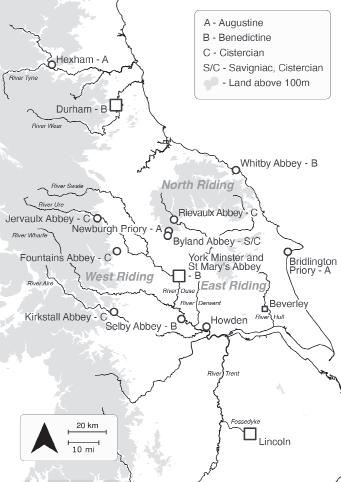THE HISTORY OF ALFRED OF BEVERLEY
Edited by J. P. T. Slevin
Translated by L. Lockyer
THE BOYDELL PRESS
© J. P. T. Slevin and L. Lockyer 2023
All Rights Reserved. Except as permitted under current legislation no part of this work may be photocopied, stored in a retrieval system, published, performed in public, adapted, broadcast, transmitted, recorded or reproduced in any form or by any means, without the prior permission of the copyright owner
The right of J. P. T. Slevin and L. Lockyer to be identified as the authors of this work has been asserted in accordance with sections 77 and 78 of the Copyright, Designs and Patents Act 1988
First published 2023
The Boydell Press, Woodbridge
ISBN 978-1-78327-488-8 (hardback)
ISBN 978-1-80010-896-7 (ePDF)
The Boydell Press is an imprint of Boydell & Brewer Ltd PO Box 9, Woodbridge, Suffolk IP12 3DF, UK and of Boydell & Brewer Inc.
668 Mt Hope Avenue, Rochester, NY 14620–2731, USA website: www.boydellandbrewer.com
A CIP catalogue record for this book is available from the British Library
The publisher has no responsibility for the continued existence or accuracy of URLs for external or third-party internet websites referred to in this book, and does not guarantee that any content on such websites is, or will remain, accurate or appropriate
Contents
vi List of Illustrations
vii Preface
ix Acknowledgements
xi List of Abbreviations
INTRODUCTION
xix Alfred of Beverley – Man, Milieu & Memory
xxviii Date and Circumstances of the History
xxxii Sources
xxxii i. Introduction
xxxii ii. Henry of Huntingdon
xxxv iii. Geoffrey of Monmouth
xliii iv. The Worcester Chronicle
xlvii v. The Durham Historia Regum
liii The Afterlife of Alfred
lx Manuscripts
lxx Historical Place, Purpose & Value
lxxv Editions
lxxv i. Previous Edition
lxxvi ii. This Edition
1 TEXT AND TRANSLATION
165 Appendices
172 General Index
Illustrations
Plates
1. Corpus Christi College Oxford, MS 157 f. 50. Reproduced by kind permission of the Masters and Fellows of Corpus Christi College, Oxford xliv
2. William Caxton, Descripcion of Britayne (1480), Chapter 4 (‘Marvels and Wonders’). Reproduced by kind permission of The British Library lix
3. Oxford, Bodleian Library, Rawlinson B 200 f. 1. Reproduced by kind permission of the Bodleian Library, Oxford lxi
4. Aberystwyth, National Library of Wales, MS Peniarth 384 f. 122. Reproduced by kind permission of the National Library of Wales lxv
5. London, British Library, MS Cotton Cleopatra A I f. 20 v. Reproduced by kind permission of The British Library lxvii
Figures
1. Charters xx
2. Sectional Plan of the Historia Regum (HR) Attributed to Symeon of Durham xlix
3. List of Surviving Manuscripts lxii
4. The Relationship of the Manuscripts lxx
Map
1. Centres of Historical Writing in Yorkshire and Surrounds, 1100–1200 xvii
The editor and publisher are grateful to all the institutions and persons listed for permission to reproduce the materials in which they hold copyright. Every effort has been made to trace the copyright holders; apologies are offered for any omission, and the publisher will be pleased to add any necessary acknowledgement in subsequent editions.
Preface
The History of Alfred of Beverley narrates the history of Britain from its supposed foundation by the Trojan Brutus down to the death of Henry I in 1135. The History of Alfred of Beverley is the more appropriate name for the Latin text which has become known, from its previous edition in 1716, as Alfred’s Annals. The text, for its greater part, is not written in annalistic form but is comprised of self-contained chapters which each address a distinct narrative theme. Within the chapters, dating is predominantly supplied by regnal year.
Compiled over the years c.1148–c.1151, and at a time of crisis and schism in the church of York, the work was sparked by the appearance in c.1136 of Geoffrey of Monmouth’s History of the Kings of Britain, and by the astonished reaction in literate circles of the time to that work. What appears to have been Alfred’s original intention, to make excerpts of those parts of the work which did not ‘exceed the bounds of credibility’, developed into a more ambitious attempt to integrate Geoffrey’s History into an existing understanding of Britain’s early history, based largely on the accounts of classical authorities such as Orosius, Eutropius and Suetonius, and on Bede’s Historia Ecclesiastica . The historian Henry of Huntingdon, a decade earlier, had written an epitome of Geoffrey’s History, the Epistola ad Warinum, including it in copies of his Historia Anglorum (HA) which circulated from the early 1140s, but he inserted it only as a standalone piece. Henry made no attempt to revise the early sections of the HA in the light of Geoffrey’s newly revealed history – an indication, perhaps, of misgivings about its veracity. Alfred is the first Insular chronicler attempting to do so, and his abridgement and general handling of the text therefore provides valuable insight into the very earliest reception to Geoffrey’s History.
To assimilate the History of the Kings of Britain within existing historical understanding required its content to be significantly adapted. Alfred therefore reworks its two-thousand-year continuous narrative, dividing it into five distinct historical periods, designated the quinque status, and these occupy the first five chapters of the book. Alfred’s periodization of Britain’s early history, from its foundation to the end of the dominion of the British kings, was later to be
taken over by Ranulf Higden in his influential fourteenth-century universal history, Polychronicon, and from there it passed to William Caxton and Tudor historiography.
Chapters six to nine of Alfred’s History narrate the foundation of the heptarchic English kingdoms, the emergence of West Saxon hegemony and the creation of the kingdom of England, the Danish wars and the coming of the Normans. Alfred compiles his account from three main sources: from Lincoln, the HA of Henry of Huntingdon (a source of particular influence in the compilation); from Worcester, the Accounts and Genealogies of the Saxon dynasties contained in the preliminary section of the Chronicle of John of Worcester; and, from Durham, the Historia Regum attributed to Symeon of Durham. Although well over 90 percent of the content derives from these sources, by the skilful selection, weaving and arranging of his material, Alfred composes his own distinct historical account, creating new narrative from old.
Acknowledgements
This edition began its life at the photocopying machine at the Institute of Historical Research in 2003 when emeritus Professor John Gillingham, then teaching a module on a Medieval History Master’s course at Birkbeck College, U.O.L. (Historical Writing in Twelfth-Century England), suggested to the editor that he might ‘take a look at Alfred of Beverley’ as a dissertation subject. I am thankful I had the good sense to take the professor’s advice. The ‘look’ at Alfred later continued its journey to doctoral research, under the inspirational guidance of Professor Julia Crick, Professor of Palaeography and Manuscript Studies at Kings College, London. Later still, assisted by Dr Lynda Lockyer, the task of preparing, editing and translating the present text of Alfred’s history began. Special thanks must here be given to Professor David D’Avray, for encouraging the project and for bringing together both fledgling editor and so able a translator as Lynda, to progress the task.
Along the way, thanks and gratitude must be expressed to the many scholars who have so freely given their time and advice, for without their help and support, the edition could never have been completed. Thanks therefore first to Julia Crick, David Rollason, Huw Pryce and Ian Short. Thanks also to Nicholas Orme, Christopher Holdsworth, David Luscombe, Paul Brand and Ceridwen Lloyd-Morgan. Thanks also to Astrid Khoo, former research assistant on the Exon Domesday Project, who provided expert palaeographical support. Paul Russell of the Department of Anglo-Saxon, Norse and Celtic Studies at Cambridge University generously provided access to a microfilm of a manuscript witness of Alfred’s history, BnF, MS Lat 4126, part of the Department’s Geoffrey of Monmouth Research Project collection. The librarians and staff at the British Library, the Bodleian Library, the National Library of Wales and the Institute of Historical Research in London have all provided invaluable support in locating texts and manuscripts relevant to the study.
Finally, a special thanks to both the editor of the Boydell Medieval Text series, Professor Rodney Thomson, for providing critical editorial support, and to Richard Barber of Boydell and Brewer, for entrusting to two independent
researchers the important task of bringing a neglected medieval chronicle to print, and thus making it accessible to the wider scholarly community. We hope we have done justice to the task.
J.P.T.S. & L.L.
Abbreviations
AB Alfred of Beverley.
ANS Anglo-Norman Studies.
ASC The Anglo-Saxon Chronicle: A Revised Translation, ed. D. Whitelock with David C. Douglas and Susie L. Tucker (London, 1961).
ASW F. E. Harmer, Anglo-Saxon Writs (Manchester, 1952).
BMBTC Richard Morris and Eric Cambridge, with an Appendix by Ian Doyle, ‘Beverley Minster Before the Early Thirteenth Century’ in Medieval Art and Architecture in the East Riding of Yorkshire, ed. C. Wilson (British Archaeological Association Conference Transactions, 9, 1989), pp. 9–32.
BMF Beverley Minster Fasti, ed. Richard T. W. McDermid, YARS, vol. cxlix (Huddersfield, 1990).
Brett M. Brett, ‘John of Worcester and his contemporaries’, in The Writing of History in the Middle Ages: Essays presented to Richard William Southern, eds R. H. C. Davis and J. M. Wallace-Hadrill (Oxford, 1981), pp. 101–26.
CBMLC Corpus of British Medieval Library Catalogues.
Chron. Steph. Chronicles of the Reigns of Stephen, Henry II and Richard I, ed. R. Howlett, 4 vols, Rolls Series (RS) (London, 1884–89).
CJW ii, iii The Chronicle of John of Worcester, vol. ii, ed. R. R. Darlington, P. McGurk and J. Bray (OMT, 1995), vol. iii, ed. and trans. P. McGurk (Oxford, 1998).
CPEE Chronica Pontificum Ecclesiae Eboracensis.
CS Councils and Synods with Other Documents relating to the English Church, vol. i (871–1204), eds D. Whitelock, M. Brett and C. N. L. Brooke (2 parts: Oxford, 1981).
CSEL Corpus Scriptorum Ecclesiasticorum Latinorum (Vienna 1866–).
DC Descriptive Catalogue of Materials Relating to the History of Great Britain and Ireland, ed. T. D. Hardy, 2 vols, RS (London, 1862–71).
DEB Gildas, De Excidio Britonum. The Ruin of Britain and other works, ed. and trans. Michael Winterbottom (Chichester, 2002).
Eadmer, HN Eadmeri Historia Novorum in Anglia, ed. J. M. Rule, RS (London, 1884).
EAW Epistola Ad Warinum Britonum, HA, vol. viii, pp. 558–83.
EEA English Episcopal Acta v. York 1070–1154, ed. Janet Burton (British Academy, Oxford, 1988).
EYC Early Yorkshire Charters, vols i–iii, ed. W. Farrer (Edinburgh 1914–16); vols iv–xii, ed. C. T. Clay (YASRS, extra series, 1935–65).
FW MHB Florentii Wigorniensis in Monumenta Historica Britannica, ed. H. Petrie and illustrated by J. Sharp, vol. i (London, 1848), pp. 616–44.
FW Thorpe Florentii Wigorniensis Monachi, Chronicon ex Chronicis, ed. B. Thorpe, Sumptibus Societatis, vol. i (London, 1848).
Gaimar Geffrei Gaimar, Estoire des Engleis, ed. I. Short (Oxford, 2009).
GC Opera Giraldus Cambrensis Opera, eds J. S. Brewer, J. F. Dimock and G. F. Warner, 8 vols, RS (London, 1861–91).
GC Works The Historical Works of Gervase of Canterbury, ed. William Stubbs, 2 vols, RS (London, 1879–80).
GM Geoffrey of Monmouth.
GND The Gesta Normannorum Ducum of William of Jumièges, Orderic Vitalis and Robert of Torigni, ed. E. M. C. van Houts, 2 vols, OMT (Oxford, 1992–5).
GP William of Malmesbury, Gesta Pontificum Anglorum, ed. N. E. S. A. Hamilton, RS (London, 1870).
GRA William of Malmesbury, Gesta Regum Anglorum, eds R. A. B. Mynors, R. M. Thomson and M. Winterbottom, 2 vols, OMT (Oxford, 1998–99).
xii abbreviations
Green HI Judith A. Green, Henry I, King of England and Duke of Normandy (Cambridge, 2009).
GS Gesta Stephani, eds K. R. Potter and R. H. C. Davis (Oxford, 1976).
HA Henry, Archdeacon of Huntingdon, Historia Anglorum. The History of the English People, ed. and trans. Diana Greenway, OMT (Oxford, 1996).
HAB Historia Aluredi Beverlacensis, The History of Alfred of Beverley
HB Nennius, British History and The Welsh Annals, ed. and trans. John Morris (London, 1980).
HBC Handbook of British Chronology, eds E. B. Fryde, D. E. Greenway, S. Porter and I. Roy (London, 1986).
HC Hugh the Chanter, History of the Church of York 1066–1127, ed. C. Johnson, rev. M. Brett, C. N. L. Brooke and M. Winterbottom (Oxford, 1990).
HCY Historians of the Church of York and of its Archbishops, ed. J. Raine, 3 vols, RS (London, 1879–94).
HE Bede’s Ecclesiastical History of the English People, eds B. Colgrave and R. A. B. Mynors (Oxford, 1969; rev. edn. 1990).
Hearne, ABA Aluredi Beverlacensis Annales, sive Historia de Gestis Regum Britanniae Libris IX (Oxford, 1716).
HH Henry of Huntingdon.
HN The Historia Novella by William of Malmesbury, ed. K. R. Potter, NMT (London, 1955).
HR Symeon of Durham, Historia Regum, in SD, vol. ii, pp. 1–283.
HRB Geoffrey of Monmouth, The History of the Kings of Britain, ed. M. D. Reeve and trans. Neil Wright, Arthurian Studies LXIX (Woodbridge, 2007).
HTC Hugh the Chanter. The History of the Church of York 1066–1127, ed. Charles Johnson, NMT (London, 1961), rev. M. Brett, C. N. L. Brooke and M. Winterbottom, OMT (Oxford, 1990).
HWAB John P. Slevin, ‘The Historical Writing of Alfred of Beverley’ (unpublished Ph.D. dissertation, University of Exeter, 2013). Available in Open Research Exeter http://hdl.handle. net/10871/14432
HWE i, ii Antonia Gransden, Historical Writing in England c.550 to c.1307, i (London, 1974); Historical Writing in England ii, c.1307 to the Early Sixteenth Century, ii (London, 1982).
JH John of Hexham’s continuation of SD HR in Symeonis Monachi Opera Omnia, ed. T. Arnold, 2 vols, RS (London, 1882–5), ii. pp. 283–332.
JW John of Worcester.
Kirby EEK D. P. Kirby, The Earliest English Kings (London, 1991).
Leach BCAB Memorials of Beverley Minster: The Chapter Act Book of the Collegiate Church of S. John of Beverley AD 1286–1347, ed. A.F. Leach, 2 vols, Surtees Society (SS) (Durham, 1898–1903).
Memorials Memorials of St Edmund’s Abbey, ed. T. Arnold, 3 vols, RS (London, 1890–96), i. pp. 26–92.
MGH Monumenta Germaniae Historica (Scriptores Rerum Germanicarum).
MHB Monumenta Historica Britannica, vol. i, ed. H. Petrie and J. Sharp (London, 1848).
MLGB Medieval Libraries of Great Britain: A List of Surviving Books, ed. N. R. Ker, Royal Historical Society, Guides and Handbooks no. 3 (London, 1964).
Narratio Hugh of Kirkstall, Narratio de Fundatione Fontanis Monasterii, in Memorials of the Abbey of St Mary of Fountains, 3 vols, i, ed. J. R. Walbran, SS, 42 (Durham, 1863).
NMT Nelson’s Medieval Texts.
Observations John P. Slevin, ‘Observations on the twelfth-century Historia of Alfred of Beverley’, Haskins Society Journal, 27 (2015), pp. 101–28.
ODNB Oxford Dictionary of National Biography.
Om. Material omitted by AB in quoting from source material in History.
OMT
Oxford Medieval Texts.
OV The Ecclesiastical History of Orderic Vitalis, ed. M. M. Chibnall, 6 vols, OMT (Oxford, 1969–80).
PHR Paulus Historia Romana, MGH, ed. H. Droysen (Berlin, 1879).
PO Pauli Orosii Historiarum Adversum Paganos Libri VII, ed. K. Zangemeister, CSEL, v (Vienna, 1882).
Polychron Polychronicon Ranulphi Higden Monachi Cestrensis, eds Churchill Babington and J. R. Lumby, 9 vols, RS (London, 1865–86).
RH Roger of Howden, Chronica Rogeri de Houedene, ed. W. Stubbs, 4 vols, RS (London, 1868–71).
R. Hexham De Gestis Regis Stephani et de Bello Standardii in Chron. Steph., vol. iii, pp. 137–78.
RHS Royal Historical Society.
Rollason HRAD ‘Symeon of Durham’s Historia de Regibus Anglorum et Dacorum as a Product of Twelfth-century Historical Workshops’ in The Long Twelfth-Century View of the Anglo-Saxon Past, eds Martin Brett and David A. Woodman (Ashgate, 2015), pp. 95–111.
RRAN Regesta Regum Anglo-Normannorum, 4 vols: vol. i, eds H. W. C. Davis and R. J. Whitwell (Oxford, 1913); vol. ii, eds C. Johnson and H. A. Cronne (Oxford, 1956); vols iii and iv, eds H. A. Cronne, R. H. C. Davis and H. W. C. Davis (Oxford, 1968).
RS Rolls Series.
Ruff. Charters Rufford Charters, ed. C. J. Holdsworth, Thoroton Society Record Series, 4 vols (29, 30, 32, 34) (Nottingham, 1972–81).
Torigni The Chronicle of Robert of Torigni, in Chron. Steph., vol. iv, pp. 3–315.
Sawyer ASC Anglo-Saxon Charters. An Annotated List and Bibliography, ed. P. H. Sawyer, RHS (London, 1968).
SD Symeonis Monachi Opera Omnia, ed. T. Arnold, 2 vols, RS (London, 1882–85).
SS Surtees Society.
Tatlock J. S. P. Tatlock, The Legendary History of Britain. Geoffrey of Monmouth’s Historia Regum Britanniae and its early Vernacular Versions (Berkeley, 1950).
VCH Bev The Victoria History of the Counties of England. A History of the County of York East Riding, ed. K. J. Allison, vol. vi, The Borough and Liberties of Beverley (Oxford, 1989).
WM William of Malmesbury.
WN HRA William of Newburgh, Historia Rerum Anglicarum in Chron. Steph., vol. i, I–408, vol. ii, pp. 1–385.
WP Gesta The Gesta Guillelmi of William of Poitiers, eds and trans. R. H. C. Davis and Marjorie Chibnall (Oxford, 1998).
YASRS Yorkshire Archaeological Society Record Series.
Map 1 Centres of Historical Writing in Yorkshire and Surrounds, 1100–1200
Introduction
Alfred of Beverley – Man, Milieu & Memory
What little is known of Alfred the man derives from three principal sources: the surviving charters in which he appears as a witness, internal evidence from the History he wrote and his commemoration in later historical and hagiographical literature.
Charters
Five charters survive in which Alfred of Beverley is named as a witness. These confirm that he was active during the period c.1135–54 and give information about the religious communities with which he had contact and the circle in which he moved. In the East Riding of Yorkshire such contact included the Augustinian priories of Bridlington, founded before 1114; Warter, founded in 1132, and the Gilbertine priory of Watton, a double house of canons and nuns founded in c.1150 x 1153 by Eustace fitz John and his wife Agnes.1
Alfred’s attestation of William Tyson’s confirmation of a gift of land in Averham, in the East Riding, to the Cistercian Rufford Abbey (Nottinghamshire), founded in 1146, is of particular interest. Preserved in the fifteenth-century Rufford cartulary, the attestation not only shows Alfred’s association with a Cistercian abbey located over sixty miles from Beverley, but also names Ernaldo filio Alueredi as a witness (Figure 1, charter no. 5). The name Ernaldus is not listed immediately after Alueredo Sacrista – he is the twelfth named and Alfred is third – but there are reasonable grounds to consider that Ernaldus was the son of Alfred the sacrist. We learn from this charter therefore that Alfred was a family man, either married, or (in common with many secular clerks of the period) living in concubinage. In all these charters Alfred is named as sacrist – in later medieval sources he is described as thesaurarius, treasurer – attesting evolution in the organisation of the church of Beverley and in the role of its dignitaries over the period. In charter no. 2, in favour of the burgesses of Beverley, given by Archbishop William fitz Herbert (c.1143),
1 Janet Burton, The Monastic Order in Yorkshire, 1069–1215 (Cambridge, 1999), p. 137.
1 EYC i. no. 104
Figure 1 Charters
c.1135–47
2 EYC i. no. 105
EEA v. no. 86
3 EYC ii. no. 1108
EEA v. no. 129
c.1143–47
Cyrograph of the confirmation of Thurstan (provost) and the Beverley Chapter, of alms to canons of Bridlington priory, as originally granted by Thomas (provost) and the canons of his time.
Charter of Archbishop William fitz Herbert of York to the burgesses of Beverley confirming the previous grant of Archbishop Thurstan of free burgage to Beverley, as per York.
c.1151–53 Notification by Archbishop Henry Murdac of York before the Beverley Chapter of confirmation of the gift of Eustace fitz John to the nuns of Watton priory.
The gift to support 13 canons of the order of Sempringham to minister to the nuns.
William, dean of York. Simon, Ralph, Roger, canons of Beverley.
Aluredus Sacrista.
Total witnesses: 14.
William of Aumale, Robert de Stuteville (III), Everard de Ros. Thurstan (provost); Ivo abbot of Warter; Simon and Ralph, canons of Beverley.
Magistro Alfrido sacrista
Total witnesses: 20.
Adam, abbot of Meaux. William (cantor) and Robert (archdeacon) of York.
Canons of Beverley: Aelward, Ralph, Simon, Roger, William Morin.
Warin (clerk of the counts), William of Warter, Hugh and Richard Murdac and their sons Hugh and Stephen. Aluredus sacrista
Total witnesses: 26.
4 EYC x. no. 67
EEA v. no. 128
5 EYC xii. no. 109 Rufford Charters ii. no. 303
c.1151 Confirmation by Archbishop Henry Murdac of York and notification to Robert (the dean) and the Chapter of York of the grants made to the church of St James and the canons of Warter priory for the construction of an abbey by William de Roumare, earl of Lincoln and family.
c.1146–54 Grant in free alms by William Tison to Rufford Abbey (Cistercian) of land in ‘Arthes’ in Averham, East Riding of Yorkshire.
William (cantor) and Robert (the archdeacon) of York.
Canons of Beverley: Aelward, Ralph, Simon, Nicholas, William, Philip.
Alueredus Sacrista.
Total witnesses: 8.
Canons of Beverley: Simon et Roger. Stephen Murdac.
Alueredo sacrista, Ernaldo filio Alueredi
Total witnesses: 17
Alfred is described as Magister – although the school at which he earned his title remains unknown.2
Alfred’s co-witnesses in the five charters number over eighty and are a source of valuable information. Fifteen are senior clergy, including dignitaries and officers of the chapters of York and Beverley and abbots and priors of East Riding religious houses. Other witnesses represent a cross section of the landowning aristocracy of the East Riding of Yorkshire. Amongst them is William le Gros, count of Aumale (c.1110–1179) who had been a leading lay opponent of Archbishop Henry Murdac in the disputed election in 1141 and again in 1147, but who later, having reconciled with Archbishop Henry, founded the Cistercian abbey of Meaux in January 1151. William also founded the priory of Thornton (1139), the abbey of Bytham (1147), and was co-founder of North Ormsby Priory (1148–54). 3 Other notable witnesses are Robert de Stuteville III (d.1183), a benefactor of Meaux Abbey and probable founder of Keldholme Priory4 and Everard de Ros, nephew of Walter Espec, Lord of Helmsley and one of William of Aumale’s principal tenants in the strategically important lordship of Holderness in the East Riding. 5 Everard’s presence as a witness alongside Alfred (Figure 1, charter no. 2) is noteworthy because it places Alfred within touching distance of a leading literary patron of the period. Everard’s uncle, Walter Espec, founder of the Augustinian priory of Kirkham (c.1121) and Fountains (1132) and lover of history, was the magnate who lent lady Constance fitz Gilbert the copy of Geoffrey of Monmouth’s HRB which Geoffrey Gaimar used as a source text for his Estoire des Engleis, as he himself informs us in the Estoire 6
Among senior ecclesiastical figures in the group of co-witnesses are William of Sainte-Barbe, dean of York and supporter of Henry Murdac in the York archiepiscopal election of 1141 and later bishop of Durham (1143–1152), William
2 The authenticity of this charter of Archbishop William has recently been challenged. See David X. Carpenter and Richard Sharpe, ‘Subversive Acts: The Early Charters of the Borough of Beverley’, History. The Journal of the Historical Association, vol. 103, December 2018, pp. 715–924 at 719–36. The authors set out evidence that the charter to the burgesses of Beverley (c.1143) granting them free burgage, as earlier granted by Archbishop Thurstan, and long regarded as one of England’s earliest town charters, was one of three charters forged by the burgesses of Beverley in c.1180. This was done, it is argued, in order to obtain an authentic royal town charter from Henry II after the death of Archbishop Roger of Pont l’Evêque in c. November 1181, and before a new archbishop was in place. The charter granted by Henry II confirmed the liberties and free customs which Archbishops Thurstan and William had supposedly granted the burgesses of Beverley and which Henry’s grandfather (Henry I) had confirmed, and was issued at Arundel castle c. February 1182 and is printed in EYC, i, no. 110, pp. 103–04.
3 Paul Dalton, ‘William le Gros, count of Aumale and earl of York (c.1110–1179)’, ODNB, 59 (Oxford, 2004), pp. 122–23.
4 Hugh M. Thomas, ‘Stuteville, Robert (III) de (d. 1183), ODNB, 53 (Oxford, 2004), p. 259.
5 Paul Dalton, Conquest, Anarchy and Lordship, Yorkshire 1066–1154 (Cambridge, 1994), p. 182.
6 Gaimar, pp. 348–51, lines 6435–6483.
d’ Eu the precentor (c.1140–c.1178)7 and Robert Butevilain, archdeacon and later dean of York (1158–1186). Robert is described as magister in a charter of Henry Murdac in favour of Kirkstall Abbey8 in which one of the co-attestors was Nicholas de Trailly, the same York canon whom Geoffrey Gaimar had singled out, in the epilogue of the Estoire des Engleis, as a source who could attest the veracity of his historical account.9 Two prominent monastic leaders in the region are among the co-attestors: Adam, first abbot of the Cistercian abbey of Meaux and formerly monk of Fountains (1151–60) and Ivo, abbot of Warter priory, which, during its Arrouaisian phase (c.1142–c.1197), assumed the title of abbey.10
The Church of St John of Beverley
The collegiate church of St John the Evangelist and St John of Beverley, at the time of Alfred, served as the mother church of the East Riding of Yorkshire, providing pastoral care for an area extending from the Humber River in the south to Folkton in the north, and from Holderness in the East to the borders of York in the west.11 Ministering for so large an area, Beverley acted as a departmental sub cathedral in the administration of the vast diocese of York and its archbishops held a stall in the choir12 and a residence in the town.13 The church had been named mynstre in a writ of Edward the Confessor (c.1060–65) to Earl Tosti and the king’s thegns in Yorkshire confirming Archbishop Ealdred (1061–1069) as sole temporal lord of Beverley, under the king, authorising him to draw up a privilegium for the lands belonging to the minster.14 The writ confirmed that this privilege was to be enjoyed by successor bishops and that minster life and assembly should always be maintained at Beverley ‘as long as any man shall live’.
The contribution of the last three Anglo-Saxon archbishops of York –Ælfric Puttoc (1023–1051), Cynesige (1051–1060) and Archbishop Ealdred – to establishing Beverley’s pre-eminent position in the East Riding is well-attested. The anonymous Chronica Pontificum Ecclesiae Eboracensis (hereafter CPEE),
7 D. Carpenter, ‘The Dignitaries of York Minster in the 1170s: A Reassessment’, Northern History, xliii (March, 2006). On the evidence of two previously unpublished charters, it has been established that William d’Eu survived until 1178 or later.
8 EEA, v. no. 121.
9 Gaimar, p. 350, line 6482.
10 Burton, Monastic Order, p. 96, note 118.
11 For summary surveys of the church and town of Beverley in the eleventh and twelfth centuries see R. E. Horrox, ‘Medieval Beverley’ in VCH Bev, pp. 2–57; Leach, BCAB, i. pp. ix–cvi; BMF, pp. xv–xxx; D. M. Palliser, ‘The Early Medieval Minster’ in Beverley Minster an Illustrated History, ed. Rosemary Horrox (Cambridge, 2000), pp. 23–35; BMBTC, pp. 9–32.
12 Leach, BCAB, i. p. xlvii.
13 Horrox, Medieval Beverley, VCH Bev, p. 14.
14 ASW, no. 7, pp. 135–38; Sawyer, 1067, p. 318; EYC, i. 87, pp. 85–86.
compiled shortly after the death of Archbishop Thurstan in 1140, 15 provides considerable detail of their benefactions to the minster.16 Archbishop Ælfric secured St John’s canonization in 1037 and translated his relics to a magnificent new shrine.17 Cynesige added a high stone tower with two bells, continued work on the building of a communal dormitory and refectory, and adorned the church with books and ornaments. Archbishop Ealdred completed the building of the minster refectory and dormitory begun by his two predecessors,18 improving and extending them. He built a new presbytery dedicated to St John the Evangelist, and, according to the anonymous author of the CPEE, ‘adorned it with “sculptures and paintings of incomparable beauty”’.19 Then he purchased from King Edward the rights for Beverley to hold an annual fair on the feast of St John the Baptist: “feriam quoque annuam in nativitate Sancti Joahannis Baptistae cum libertatibus et optimis consuetudinibus a rege Edwardo datis xii. marcis comparavit”.20 Ealdred promoted both the cult of St John and Beverley’s attractiveness as a pilgrimage centre by commissioning the professional hagiographer Folcard, a monk of St Bertin’s at St Omer, to write a life of St John in the 1060s.21
York’s first Norman archbishop, Thomas of Bayeux (1070–1100), Hugh the Chanter informs us, remodelled the chapter of York, turning it from one where the canons lived in common, into a prebendal system, where each canon ‘might cultivate his own share for his own sake’.22 Beverley, however, retained its communal character for the greater part of the twelfth century, with a common dormitory and refectory – known later as the Bedern – and corporate fund.23 According to the later medieval Beverley Provosts Book (c.1415),24 Archbishop Thomas I in 1092 created a provostry in Beverley, appointing his nephew Thomas (later Archbishop Thomas II of York) as its first provost, to administer the assets and income of the minster and with the authority to appoint the dignities of chancellor, precentor and sacrist. An important component of Beverley’s income was a grain render from every parish of the East Riding, described as thraves in a writ of Henry (c.1122 x 1127) to the sheriffs and king’s officials in Yorkshire.25 A charter of
15 BMBTC, p. 12.
16 Pars Prima of the chronicle extending to the death of Thurstan in 1140 is printed in HCY, ii. pp. 312–87. The chronicle is mainly derived from Bede, Symeon of Durham, Hugh the Chanter and Folcard, but for Beverley it provides original testimony. See the discussion in HCY, ii. pp. xxi–xxii.
17 HCY, ii. p. 343.
18 Ibid., ii. p. 353.
19 Ibid., ii. p. 354.
20 Ibid., ii. p. 354.
21 Ibid., i. pp. 239–60. Frank Barlow, The English Church 1000–1066 (London, 1979), pp. 89–90.
22 HC, pp. 18–19.
23 BMF, pp. xviii–xix, where the author contends that the introduction of a prebendal system at Beverley is likely to have begun during the early years of the episcopacy of Roger of Pont l’Evêque (1154–81).
24 Leach, BCAB, ii. 332–33.
25 EYC, i. no. 97, p. 93.
King Stephen to the church of Beverley (1136), confirming the privileges, gifts, liberties and midsummer fair granted to the church of St John by King Edward and William I, stated the thraves due were ‘four from each plough and ploughshare throughout the East Riding, and on the king’s demesne manors’. 26 Stephen’s charter also confirmed Beverley to have the right of a peace league around the church of St John of Beverley as granted by King Æthelstan – the earliest record linking Æthelstan to Beverley. From roughly this time, however, accounts of the foundation of Beverley by Æthelstan, elaborated at various levels of detail, appear in hagiographical, chronicle and literary sources.27
Charters and episcopal acta of the period c.1140–1160 preserve the names of provosts, sacrists and canons active in Beverley at the time of Alfred. Provosts include Thurstan (c.1142–c.1152)28 and Thomas Becket (c.1154–1162).29 Alfred himself is the first recorded sacrist, but by c.1157 a Robert was attesting as sacrist in his place.30 The names of seven canons from the time include Aelward, Ralph, Simon, Nicholas, William, Philip and Roger (Figure 1). Those of the dignitaries of precentor and chancellor and the canons’ vicars – the clerks who deputised for the canons when they were absent from the minster – have come down to us only from later in the twelfth century.31 That the canons were at hand to witness episcopal charters in sizeable groups during the episcopacy of Henry Murdac in the early 1150s suggests a largely residentiary chapter leading a local, corporate existence.32
The surviving charters therefore provide a snapshot of the community of clergy, lay aristocrats and local gentry among whom Alfred moved. The sources of the books used to compile his History are also suggested. Alfred is linked to wellestablished religious communities, such as Warter, Kirkham and the Augustinian priory of Bridlington. Bridlington, some twenty miles north-east of Beverley, was
26 RRAN, iii. no. 99, p. 36; EYC, i. no. 99, pp. 93–94. For a discussion on medieval thraves and their value see BMF, p. xvi, note 9.
27 A version of the Æthelstan foundation story is found in a collection of miracle stories appended to the earliest extant copy of Folcard’s Life of St John from the Cistercian Abbey of Holme Cultram in Cumbria (BL, MS Cotton Faustina B. IV) and written in a hand of c.1175 (BMBTC, p. 29, note. 52). The collection is printed in HCY, i, pp. 261–91. Aelred of Rievaulx’s Genealogia Regum Anglorum, a mirror for princes written for Henry, duke of Anjou, in 1153, contains a version of the foundation account very similar to that contained in the Holme Cultram manuscript (The Genealogia is printed in PL, CXCV, Cols 711–38 at col. 724–25). See also Aelred of Rievaulx: The Historical Works, ed. Marsha L. Dutton and trans. Jane Patricia Freeland (Kalamazoo, Michigan, 2005), pp. 90–92. The Liberties of Beverley text, attributed to Alfred of Beverley, contains a further version of the story (see p. xxvi, below).
28 EYC, i. no. 152.
29 Ibid., i. no. 155.
30 Ibid., xii. no. 23 and see BMF, p. 113.
31 BMF, p. 123. A magister William is the first known precentor from c.1199. The first known magister scolarum or chancellor, is magister Angotus c.1178 (BMF, p. 118). The earliest vicars named date from the early thirteenth century (BMF, p. 127).
32 BMF, p. xx.
a centre of some literary accomplishment at the time. Its prior was Robert, ‘the Scribe’ (c.1147–50–c.1160), author of The Bridlington Dialogue and glosses on Exodus, the Minor Prophets and St Paul. Robert’s commentary on the Minor Prophets was requested by Gervase, abbot of the Cistercian abbey of Louth Park in Lincolnshire, founded in 1139 by Bishop Alexander of Lincoln. The priory was thus in contact with other communities with scholarly interests, extending beyond the East Riding of Yorkshire,33 and its scholarly interests are attested by five surviving books from the period.34 A book list from Bridlington is preserved in a late twelfth century glossed copy of the gospel of St Mark (BL MS Harley 50) which lists some seventy-seven major titles and some forty parvi libelli contained in the priory’s magnum armarium 35
Internal Evidence
The little Alfred reveals of himself in the History is found early. In the prologue we are told of his interest in history and, with due modesty, that he was considered by his peers to be an accomplished writer – suggesting his community might have encouraged him in his historical enterprise. At the conclusion of the prefatory descriptive survey of Britain, he comments that the removal of the Flemings by Henry I in c.1110 to Rhos in Dyfed, Pembrokeshire, Wales, occurred ‘in our own time’, providing a clue to a likely date of birth. As noted, a Robert attests as sacrist in c.1157, along with the chapter of Beverley, in a charter of Watton Priory, suggesting that Alfred had died and been replaced by that date.36 If he were alive in 1110 and lived to old age, as described in hagiographical sources,37 it appears likely that he was born in the closing decades of the eleventh century.
Commemoration
Two late fourteenth-century items – one from Beverley, the other from York –indicate that Alfred’s memory as a scholar and historian was actively preserved in both churches.
33 A. Lawrence, ‘A Northern English School? Patterns of production and collection of manuscripts in the Augustinian Houses of Yorkshire in the twelfth and thirteenth centuries’, in Yorkshire Monasticism: Archaeology, Art and Architecture from the Seventh to the Sixteenth Centuries, ed. L. R. Hoey, BAA Conference Transactions, 16 (Leeds, 1995), pp. 145–53, at p. 147.
34 MLGB, p. 12.
35 The Libraries of the Augustinian Canons, ed. T. Webber and A. G. Watson, CBMLC (London, 1998), pp. 8–10.
36 BMF, p. 113.
37 See pp. xxvii–xxviii below.
The Liberties of Beverley
The Beverley commemoration is found in the late fourteenth-century Beverley Cartulary (London, BL MS Add. 61901) an expensively produced volume commissioned by the chapter of Beverley in defence of its rights and privileges at a time of conflict between it and Archbishop Alexander Neville (c.1332–1392). The cartulary contains Folcard of St Bertin’s Life of St John of Beverley, collections of his miracle stories, and royal, papal and episcopal privileges of the church of Beverley.38 Folios 60 v–69 r contain the tract The Liberties of Beverley, setting out the ancient liberties of Beverley as granted by King Æthelstan after his victory over the Scots at the battle of Brunanburgh (934), giving details of the extent and the operation of its sanctuary and ‘peace league’. Alfred’s authorship of the tract is described in the introductory rubric as follows:
The Liberties of the church of Saint John of Beverley, with its papal and episcopal privileges, which Master Alfred, sacrist of that church, translated from English into Latin.
Here begin the Liberties of the church of St John of Beverley, munificently bestowed by the kings and princes of England and observed as famous up to the present day, by usage and the gathering of custom, which Master Alfred, a man of venerable life and an ardent student of the scriptures and sacrist of the aforementioned church, has committed to writing as heard from his predecessors and seen; and so that they suffer no wrong by posterity, he wrote them down with his own pen.
The History provides little supporting evidence that its author, and that of the Liberties tract, were one and the same person. Indeed, several passages in the History suggest otherwise.39 The tract, however, testifies to the preservation of Alfred’s memory in later medieval Beverley. The Liberties occupies a central place in the cartulary and is elaborately presented, making clear its significance to the compilers. In a matter of importance to the chapter of Beverley, it is Alfred’s name which is attached to the tract. He is recalled as both a scholar – able to translate ancient privileges from English into Latin – and as a historian, the collector and redactor of oral traditions.
38 For a detailed analysis of BL MS Add 61901 by Ian Doyle see BMBTC, pp. 20–27.
39 See below, HAB, viii. p. 117, note 3; p. 119, note 15; HAB, ix. p.137, note 12; p. 139, note 17
The York Minster Tablets
Extracts from the History form part of a medieval historical artefact from York Minster, indicating that Alfred’s memory was also preserved in York. In the collection of Minster Library are two tablets: large, folding wooden (oak) boxes, each consisting of three panels (triptychs), on which are fastened parchments. They are believed to date from the time of Archbishop Thomas Arundel (1388–97) and were observed on display in the Minster by John Leland in 1534, who defaced portions of text relating to papal authority in Britain.40 The Latin text on all panel parchments is in the same hand. There is no illustrated material. On the left-hand panel of the larger triptych are historical notices from Geoffrey of Monmouth, Henry of Huntingdon, William of Malmesbury, Martinus in chronicis de pontificibus and ‘Alfridus Beverlacens thesaurarius’. The central panel of the larger triptych, titled ‘Prologus de origine et statu ecclesie Eboracensis’, contains a 512-line verse account of the foundation of the church of York, which, the writer says, he composed at the time of the archiepiscopate of Thomas Arundel.41 The third, right-hand, panel of the larger triptych consists of papal bulls, archiepiscopal grants and indulgences, privileges in favour of the church of York, and notices of its metropolitan status over the Scottish bishops. The panels of the smaller triptych contain biblical material, including an account of the seven ages of man.
Hagiographical
Alfred is recalled as a participant in a miracle story from a collection of St John of Beverley’s posthumous miracles entitled Alia Miracula, Auctore ut Plurimum Teste Oculato and printed in James Raine’s Historians of the Church of York and its Archbishops, appended to Folcard’s Life of St John. 42 The collection commences with an extended account of the foundation of Beverley by King Æthelstan with a particular interest in promoting English claims to sovereignty over Scotland.43
40 For the date of the tablets see HCY, ii. p. xxviii. N. Ker and A. J. Piper, Medieval Manuscripts in British Libraries, iv, Paisley-York (Oxford, 1992), pp. 824–26, list the tablets as Add 533 and 534. Leland’s defacement is noted in James P. Carley, ‘Leland, John (c.1503–1552)’, ODNB, 33 (Oxford, 2004), pp. 297–301.
41 Printed in HCY, ii. pp. 446–63.
42 HCY, i. pp. 293–320. This miracle story collection was printed by Raine from Acta Sanctorum Bollandiana, Vita Sancti Johannis, Maii, vii, vol. ii (Antwerp, 1688), pp. 166–94, itself printed from a now-lost manuscript of Leander Pritchart, a Benedictine monk. For discussion of this lost manuscript see HCY, i. p. lvii.
43 HCY, i. p. lv. Raine dated this collection of miracle stories to c.1170–1180 but the Æthelstan foundation story component, with its account of Scotland paying tribute to Æthelstan, and the story of the king’s miraculous striking through the rock of Dunbar with his sword as a God-willed sign of the legitimacy of English sovereignty over Scotland, suggests later elaboration, possibly in the time of Edward I.
xxvii
The miracle story which involves Alfred is set during the anarchy of King Stephen’s reign. The powerful Yorkshire baron (and charter co-attestor with Alfred) Robert de Stuteville III, has imprisoned a clerk of Lincoln in his castle at Cottingham, some three miles from Beverley, holding him for ransom. One night St John appears and frees the clerk from his chains, leading him to the safety of Beverley. In the morning the clerk informs the Minster clergy of this miraculous intervention and a remaining iron ring falls from his leg in front of their eyes. The ring is then hung up in the church near the tomb of St John as a testimony to the saint’s miraculous powers. The clerk’s feet had been injured by the sharp reeds of the marshy land he crossed during his escape and, in the morning, these are tended by Alfred the sacrist, who uses his knowledge of medicine to heal them. In the story Alfred is recalled as both wise in the laws of the church and as being of advanced age:
Sacrista eiusdem ecclesiae tunc temporis fuit Alveredus, bonae memoriae, senex, ecclesiastica institutione sagax.
The sacrist in those days was Alfred of happy memory, an old man and wise in the laws of the church.
While Alfred’s involvement in the story of the imprisoned clerk of Cottingham castle is preserved in the version printed by James Raine, he is not involved in the account given in the collection of St John’s miracles preserved in the Beverley Cartulary.44
Date and Circumstances of the History
The History is commonly assigned to the year 1143, but information provided in the prologue, describing the circumstances giving rise to the work, and internal evidence from the text, indicate that the compilation started life no earlier than c.1148, and possibly, but not certainly, was completed by early 1151.45 The year 1143 was first assigned to the work by Thomas Duffus Hardy in his influential
44 London, BL MS Add 61901 f. 20 r–f. 21 r. For a translation of Folcard’s Life of St John and his miracle story collections see Susan E. Wilson, The Life and After-Life of St John of Beverley. The Evolution of the Cult of an Anglo-Saxon Saint (Ashgate, 2006), pp. 143–218.
45 An extended investigation into the date and circumstances of Alfred’s history is set out in HWAB, pp. 59–86 and also in ‘Observations’, pp. 107–12.
xxviii
